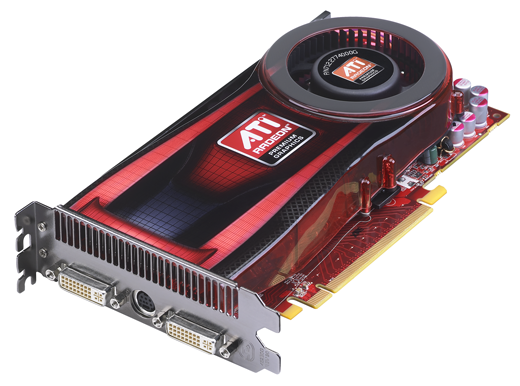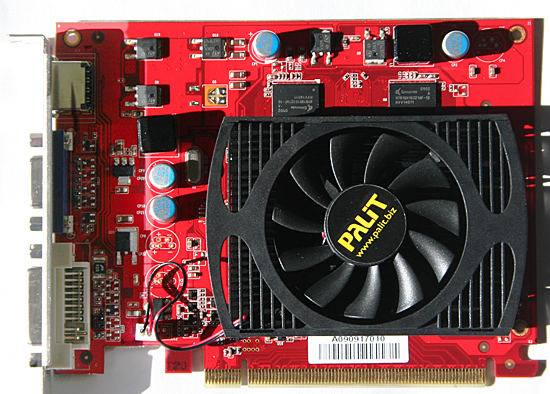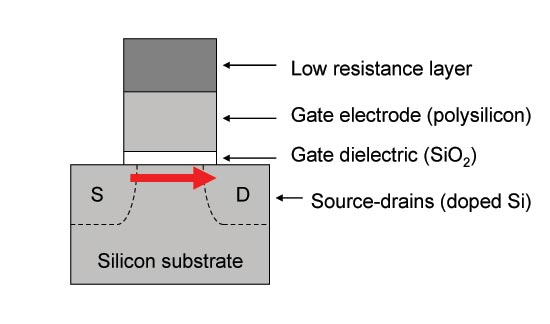The RV870 Story: AMD Showing up to the Fight
by Anand Lal Shimpi on February 14, 2010 12:00 AM EST- Posted in
- GPUs
The Payoff: How RV740 Saved Cypress
For its first 40nm GPU, ATI chose the biggest die that made sense in its roadmap. That was the RV740 (Radeon HD 4770):

The first to 40nm - The ATI Radeon HD 4770, April 2009
NVIDIA however picked a smaller die. While the RV740 was a 137mm2 GPU, NVIDIA’s first 40nm parts were the G210 and GT220 which measured 57mm2 and 100mm2. The G210 and GT220 were OEM-only for the first months of their life, and I’m guessing the G210 made up a good percentage of those orders. Note that it wasn’t until the release of the GeForce GT 240 that NVIDIA made a 40nm die equal in size to the RV740. The GT 240 came out in November 2009, while the Radeon HD 4770 (RV740) debuted in April 2009 - 7 months earlier.

NVIDIA's first 40nm GPUs shipped in July 2009
When it came time for both ATI and NVIDIA to move their high performance GPUs to 40nm, ATI had more experience and exposure to the big die problems with TSMC’s process.
David Wang, ATI’s VP of Graphics Engineering at the time, had concerns about TSMC’s 40nm process that he voiced to Carrell early on in the RV740 design process. David was worried that the metal handling in the fabrication process might lead to via quality issues. Vias are tiny connections between the different metal layers on a chip, and the thinking was that the via failure rate at 40nm was high enough to impact the yield of the process. Even if the vias wouldn’t fail completely, the quality of the via would degrade the signal going through the via.
The second cause for concern with TSMC’s 40nm process was about variation in transistor dimensions. There are thousands of dimensions in semiconductor design that you have to worry about. And as with any sort of manufacturing, there’s variance in many if not all of those dimensions from chip to chip. David was particularly worried about manufacturing variation in transistor channel length. He was worried that the tolerances ATI were given might not be met.

A standard CMOS transistor. Its dimensions are usually known to fairly tight tolerances.
TSMC led ATI to believe that the variation in channel length was going to be relatively small. Carrell and crew were nervous, but there’s nothing that could be done.
The problem with vias was easy (but costly) to get around. David Wang decided to double up on vias with the RV740. At any point in the design where there was a via that connected two metal layers, the RV740 called for two. It made the chip bigger, but it’s better than having chips that wouldn’t work. The issue of channel length variation however, had no immediate solution - it was a worry of theirs, but perhaps an irrational fear.
TSMC went off to fab the initial RV740s. When the chips came back, they were running hotter than ATI expected them to run. They were also leaking more current than ATI expected.
Engineering went to work, tearing the chips apart, looking at them one by one. It didn’t take long to figure out that transistor channel length varied much more than the initial tolerance specs. If you get a certain degree of channel length variance some parts will run slower than expected, while others would leak tons of current.
Engineering eventually figured a way to fix most of the leakage problem through some changes to the RV740 design. The performance was still a problem and the RV740 was mostly lost as a product because of the length of time it took to fix all of this stuff. But it served a much larger role within ATI. It was the pipe cleaner product that paved the way for Cypress and the rest of the Evergreen line.
As for how all of this applies to NVIDIA, it’s impossible to say for sure. But the rumors all seem to support that NVIDIA simply didn’t have the 40nm experience that ATI did. Last December NVIDIA spoke out against TSMC and called for nearly zero via defects.
The rumors surrounding Fermi also point at the same problems ATI encountered with the RV740. Low yields, the chips run hotter than expected, and the clock speeds are lower than their original targets. Granted we haven’t seen any GF100s ship yet, so we don’t know any of it for sure.
When I asked why it was so late with Fermi/GF100, NVIDIA pointed to parts of the architecture - not manufacturing. Of course, I was talking to an architect at the time. If Fermi/GF100 was indeed NVIDIA’s learning experience for TSMC’s 40nm I’d expect that its successor would go much smoother.
It’s not that TSMC doesn’t know how to run a foundry, but perhaps the company made a bigger jump than it should have with the move to 40nm:
| Process | 150nm | 130nm | 110nm | 90nm | 80nm | 65nm | 55nm | 40nm |
| Linear Scaling | - | 0.866 | 0.846 | 0.818 | 0.888 | 0.812 | 0.846 | 0.727 |
You’ll remember that during the Cypress discussion, Carrell was convinced that TSMC’s 40nm process wouldn’t be as cheap as it was being positioned as. Yet very few others, whether at ATI or NVIDIA, seemed to believe the same. I asked Carrell why that was, why he was able to know what many others didn’t.
Carrell chalked it up to experience and recounted a bunch of stuff that I can’t publish here. Needless to say, he was more skeptical of TSMC’s ability to deliver what it was promising at 40nm. And it never hurts to have a pragmatic skeptic on board.










132 Comments
View All Comments
papapapapapapapababy - Sunday, February 14, 2010 - link
Ok, ok, great read, but i have to hate a bit, 1,2,3 GO! hey Carrell here is my top priority feature for your next PRS1 -Drivers that dont suck ass-
"The performance was still a problem and the RV740 was mostly lost as a product" ...
the fuk? the 4770 is the BEST card i ever had, PERIOD. cheap, fast, cool, the perfect RV770, thanks !
bla bla Carrell "He’s single handedly responsible for getting Eyefinity included in the Evergreen stack"
Meh? who gives a sht. , Carrell give me console like gpu scaling, so we can finally play crysis at 1080p, another one for that PRS
"Carrell went to David Glenn, head of software engineering at ATI and asked"
drivers that dont suck, please?
" There were also game compatibility concerns that made ATI not interested in the software approach"
Lol i wonder why? i think i know why. Hardware, hardware, what about the software,Carrell?
ok, thats it. not much to complain this time, flawless job ati guys
f0d - Sunday, February 14, 2010 - link
long time reader/first time postingive never felt the need to post anything but with this article i really wanted to say:
"thank you"
the insights we get in these articles is amazing (i also read the first when it was done)
i like the "no technical or maketing bs" writing of this story and all the little pieces of information like with the eyefinity story and sideport
please do as much of these type of stories as possible - it must be difficult to talk to the right people and get the right information out of them and also be allowed to publish it but it makes a great read
Robert Kooijman - Sunday, February 14, 2010 - link
Awesome article Anand!Also specially created an account to inform you how impressed I am with articles like these. A real treat these behind the scenes stories in non-marketing language. Keep 'm coming, compliments!
- Friday, February 19, 2010 - link
bravowhen do the (tech industry) book's come out??
Kryten - Sunday, February 14, 2010 - link
Informative, interesting, inspirational, edifying and very well written. Here's hoping for more research and articles like this.greenguy - Sunday, February 14, 2010 - link
Hi Anand, I've been reading your stuff for 3 years or so, I just created an account to tell you how awesome that article was. Very nice work. This sort of content is why I read Anandtech. (My other favorite articles have been the SSD articles and the i5-750 article.)I especially like to hear about AMD/ATI - I like having a serious competitor to Intel out there, and I commend AMD for opening up their graphics card documentation. I hope that they continue to fund the Linux driver development (both open and closed source). I also hope their CPU division can put the heat on Intel again, especially on the low power front.
at80eighty - Sunday, February 14, 2010 - link
Anand I was just telling someone yesterday how I wish you guys got more popularity for the different approach you guys havebetween articles like this and the new beta Bench tab - I think I'm really looking forward to your proposed changes you promised this year
insurgent - Sunday, February 14, 2010 - link
I had a really great time reading the article, thanks!Markstar - Sunday, February 14, 2010 - link
Also a big thank you from me for this wonderful article.It's exactly these kind of stories that I hope to find here every morning when I start the day.
JimmiG - Sunday, February 14, 2010 - link
Well the late changes would explain why the RV870 isn't "perfect" like the 770 was. At every price point except at the high-end, it delivers more features, but less or similar performance as the previous generation. For example the 5770 is slower than the 4870, the 5750 is about the same speed and price as the 4850 and so on. Also at the high-end it's more expensive than the 4800-series ever were - the 4870 was only $299 at launch, the 5870 is still at least $399. By this month in 2009, the 4870 was down to $249!